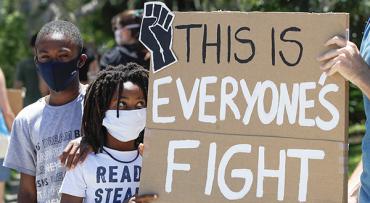AFT President Randi Weingarten kicked off a June 9 discussion, the 12th in a series of telephone town halls, with a litany of the unnecessary and tragic deaths that have occurred at the hands of the police in recent weeks. In particular, the brutal murder of George Floyd is seared into America’s collective memory; a white knee on the neck of a Black man buried the day Weingarten led this conversation.
“It’s time to right these wrongs,” Weingarten said, echoing the Rev. Al Sharpton’s words at Floyd’s funeral. “It’s frankly way past time.”
But Weingarten and the other speakers—the Rev. Herbert Daughtry, national presiding minister emeritus, The House of the Lord Churches and previously chairman of National Black United Front; Rashad Robinson, president of Color of Change; Rep. Val Demings (D-Fla.); and Jonathan Stith, national director of the Alliance for Educational Justice—were also hopeful.
Weingarten pointed out that people in all 50 states are protesting to say, “never again,” rising up against police brutality and systemic racism. And she listed significant gains made in the last two weeks: Minneapolis banned the use of choke holds; charges were upgraded against the officer who killed George Floyd and his accomplices were arrested and charged; Dallas adopted a “duty to intervene” rule that requires officers to stop other cops engaged in excessive force; and New Jersey is updating use-of-force guidelines for the first time in two decades. At the national level, House Democrats introduced legislation aimed at ending excessive use of force by police.
“Of course we have to do more,” said Weingarten. “But ultimately it’s through activism and elections, protest and politics where we must dismantle the system of racism, where we must invest in our schools, our communities and health care and disinvest in this kind of militaristic, heinous, depraved kind of policing.”
What is different this time around?
Daughtry, who at age 89 has decades of experience working for racial justice, recalled countless protests from the late 1950s through the 1970s against police brutality, and ticked off the demands he and other leading activists made at that time. They had a “Black Agenda,” he said, and did everything they could to pass it: they spoke at congressional hearings, tied up New York subways, blocked highways, met with mayors and governors and all the rest. “I’ve been in jail I don’t know how many times for civil disobedience,” he said.
What is different this time around? This movement is more diverse, it’s worldwide, it has more youthful energy and it has social media. “We didn’t have all that.” Daughtry’s long view of history also gives him hope. He grew up in the South, where he couldn’t go in the front door of a building because he is Black, he said. But, “We lived to see Obama become the president going in the front door of the White House.”
“The brutal, senseless death of George Floyd demonstrates that with all of the progress we have made the battle is not over,” said Demings. “For 400 years, racism and discrimination has been the ghost in the room.” But she agreed that this uprising is different, with two weeks of unwavering, nationwide demonstrations. And Demings, a former Orlando police chief, is hopeful about the Justice in Policing Act recently introduced in the U.S. House of Representatives. While many law enforcement organizations have recently banned chokeholds, “We want to codify it in legislation,” she said. “We continue to work to hold bad cops accountable.”
We need to build power
Robinson said there is no shortage of ideas about addressing racism—what is lacking is power. “We have a gap in our power and that is why we need friends and allies in this work,” he said. His organization focuses the energy of activists to make phone calls, attend rallies, work online and offline, and drills down to details. For example, Color of Change maintains a searchable database of 2,400 prosecutors in our country to help voters elect fair justice officials. “The goal here is to build and educate a base of people who are not only able to engage in justice issues, but translate the work into structural change,” said Robinson.
That also means investing in “things we know work, which is teachers and social workers and hospitals and mental health services, and divesting in police on every corner where we don’t have those things.”
It’s at the intersection of police and schools where Stith focuses the work of the Alliance for Educational Justice, and he applauds the Minneapolis system for severing its contract with police there. “As we are fighting for the end of police brutality in our streets we would be foolish to ignore that very same brutality that exists within our school walls,” he said, noting that attacks are typically on Black and Latinx students. “What our young people understand is that the police officer that had his knee on George Floyd’s neck is the same police officer that is body slamming them on their school grounds.” With the rise of protests and increased interest in the #policefreeschools movement, some 30 school systems are now considering severing ties with police, he said.
It is another reason for hope. “What you may be witnessing is simply the birth pain of a new age,” said Daughtry. “I hope, as we used to say in South Africa, we keep the pressure on. Don’t stop moving, broaden the base. Deepen the base. Educate, educate, educate.”
[Virginia Myers]

